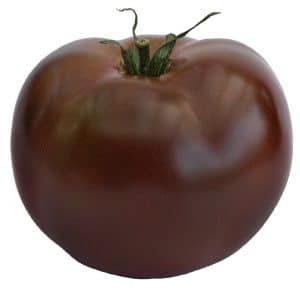How do you grow the tomato ‘Brandywine’?
‘Brandywine’ tomatoes come in various colors – pink, yellow, red, orange, and almost black. Did you ever try a black tomato? No? Me neither.
It, Brandywine, is a large tomato and is considered as being an heirloom type and is indeterminate in terms of growth habit.
It is a very popular tomato because of its delicious flavor and its amenable texture.
They are ideal to eat fresh, to add to salad dishes, for slicing and adding to sandwiches. Rather than putting them in the fridge, they are best kept in a well-ventilated area that is cool.
Besides the distinctive shape and potentially somewhat unusual coloring of the fruit, the plant itself stands out due to its bushy foliage which some would argue looks more like a potato plant than a tomato plant.
Due to this excessively bushy nature and a large amount of foliage, ‘Brandywine’ tomatoes should be pruned to prevent ‘legginess.’
What’s more is that these plants should be grown on stakes or in wire cages because they can grow particularly tall and have a tendency for snapping.
Gardener’s Supply tomato stacking ladders are a good option for tomato plant staking. Support is between 22 inches and 78 inches so these tomato supports are plenty high enough for taller, indeterminate tomato plants.
Gardener’s Supply Tomato Stacking Ladders
And don’t forget your tomato plant tie-ins. The Velcro adjustable plant ties are reusable, gentle on the plant stem, and a great price.
Velcro Adjustable Gentle Tomato Plant Ties
The fruits can weigh as much as 1.5 lbs. each (0.7kg).
The fruits take approximately 80 to 90 days to reach maturity – longer than most other tomatoes.
Sometimes, the fruit will remain green. Nevertheless, they should still be picked when green because otherwise, they will crack.
The following guidelines will help you to successfully plant and grow your ‘Brandywine’ tomatoes.

How to plant and grow ‘Brandywine’ tomato plants
1 A few weeks before the last frosts are due in your area, it’s time to sew the seeds
Add potting soil to shallow containers. Push the seeds into the potting soils to about quarter-inch depth (0.6cm).
Water well, then position your seeds/ containers so that they can enjoy a warm temperature of around 75 F (24C).
Once the seedlings rise above the soil, which should occur within a week, move them to an area that is brightly lit. They should remain there until after the final frosts.
2 Full sun for full tomato crop
‘Brandywine’ tomato plants like a slightly acidic soil – a soil of around 6.0- 6.7 pH. They also prefer the soil to have little nitrogen content – too much nitrogen only encourages the growth of foliage at the expense of tomatoes.
Your soil, when necessary, can have an organic matter supplement. The soil should also be free draining.
The location for your tomato plants should enjoy full sunshine. You’ll want plenty of space for a sizable crop because of the excessive amount of foliage these tomato plants produce.
Transfer your tomato plants to an outside area that offers some protection from the elements to allow the seedlings to “harden off.”
3 Planting ‘Brandywine’ tomatoes outside
Dig each hole so that it’s plenty large enough to host each tomato plant’s rootball.
Spacing between each tomato plant should be at least 24 inches (60cm).
Water in each plant quite thoroughly, making sure to soak the root ball but avoid dampening the foliage.
4 Staking ‘Brandywine’ tomato plants
You can use stakes or cages to provide support for your ‘Brandywine’ tomato plants.
Stakes and cages for tomato plants can be found at your local hardware shop or purchased online (see above for an excellent ladder-type tomato plant staking system available from Gardener’s Supply).
If you opt for stakes, knock them around 10 inches (25cm) into the ground. Do this just after transferring the tomato plants to an outside location to avoid disturbing the roots.
5 Prune on a weekly basis
As mentioned, because the foliage of ‘Brandywine’ tomato plants grows so densely, it’s necessary to prune regularly.
Prune weekly, and pull any suckers off since suckers do not produce fruit.
Prune out any particularly dense foliage to allow more light to get into the inner leaves of the plant.
6 How to water ‘Brandywine’ tomatoes
Water regularly. Again, just add water to the root area of the plants, and try to avoid watering the foliage as this can encourage disease.
A drip watering system is ideal for tomato plants, but if you don’t have a drip system, you can water using a watering can. Rainwater is a better proposition than tap water.
Don’t ever allow your tomato plants to completely dry out.
7 How to fertilize ‘Brandywine’ tomato plants
You can add a fertilizer that has a very low ratio of nitrogen, or even one that has zero nitrogen content and comes with an N-P-K ratio of something like 0-10-10. Of course, this depends on your soil. If your soil has little nitrogen content you’ll want your fertilizer to have some nitrogen in it.
Very low nitrogen content in the fertilizer is important for ‘Brandywine’ tomato plants given that they are so densely bushy. The more nitrogen added, the bushier they become, and the less fruit they will produce.
Some people like to maintain this low-to-no nitrogen regime until early fruits become established. At which time, they then re-integrate nitrogen at a ratio of 10-10-10 or something similar.
This will ensure that the plant itself remains healthy.
Does make some sense. My own line of thinking is that once the plant has progressed well into the fruiting stage it no longer requires any fertilizer. Basically, the plant has completed its lifecycle once fruiting is complete.



10 thoughts on “How to Grow Brandywine Heirloom Tomato Plants”